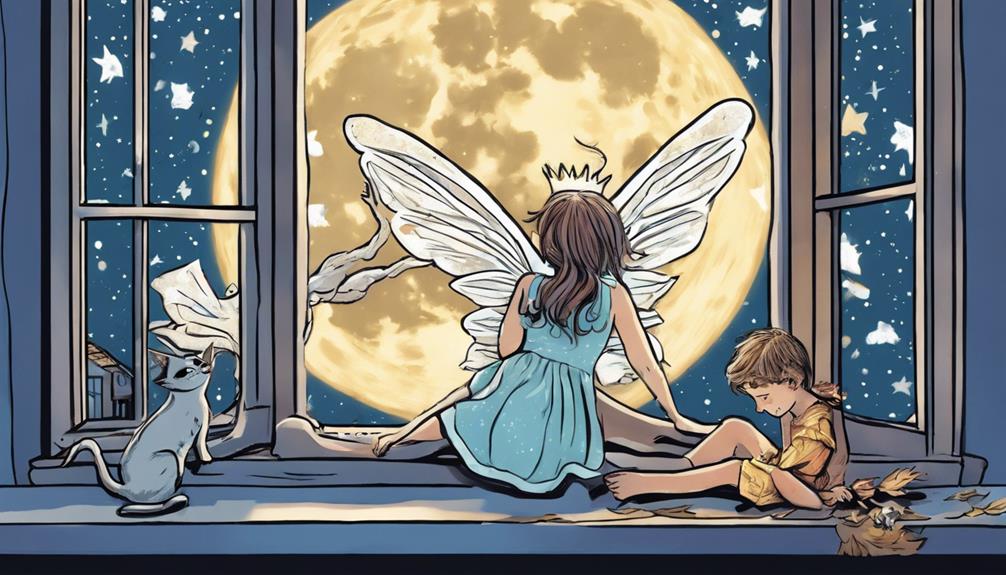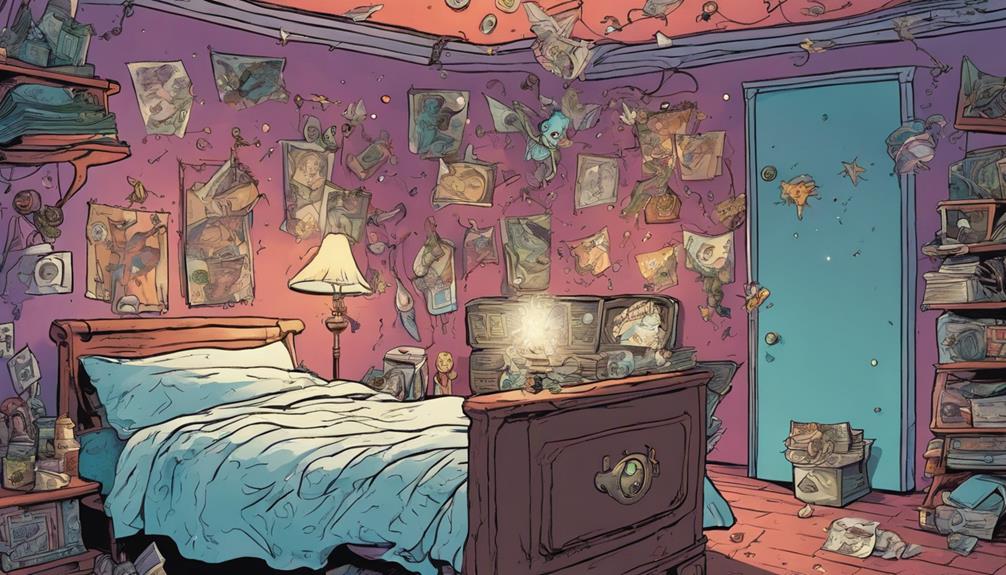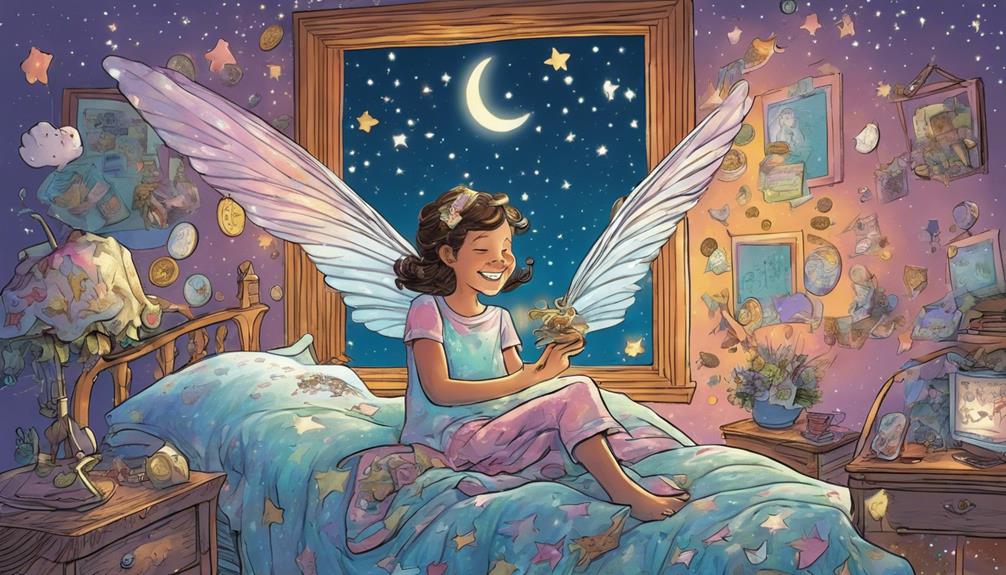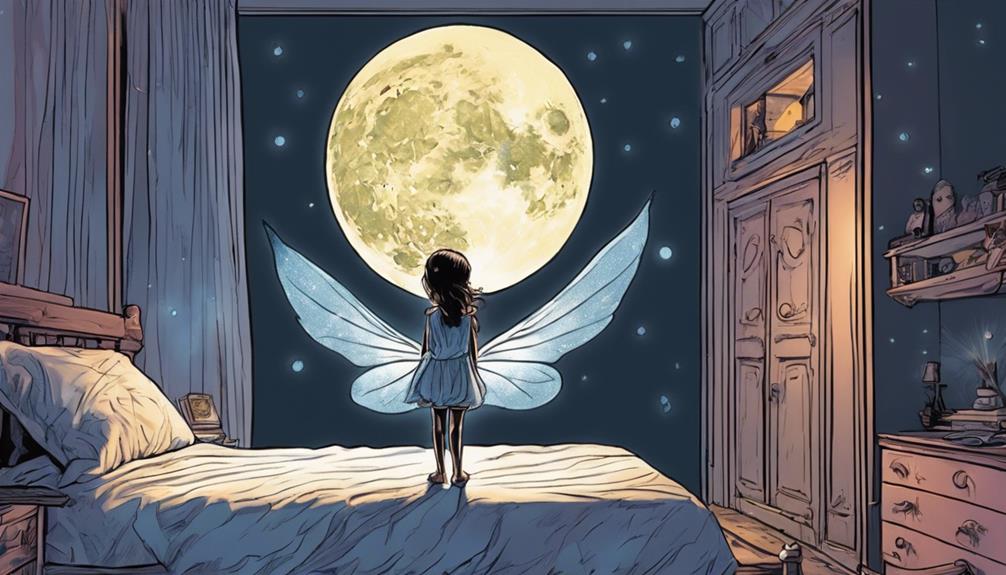The Tooth Fairy's biggest fears center on losing the magic of childhood and being forgotten as you start questioning her existence. When you lose a tooth, it marks a bittersweet moment, reminding her that belief can fade around ages 7 or 8. Cultural shifts and parental influence play a huge role, making her worry that she'll become just a distant memory. She fears being overshadowed by other myths or traditions that arise in modern times. To understand more about what drives her fears and the imagery surrounding her, you might find the next part interesting. The tooth fairy’s challenges also include the growing skepticism and cynicism of the world, which can make it harder for her to maintain her enchanting presence. She worries about how to adapt to a changing world while still fulfilling her duty to bring joy and excitement to children. Her fear of being forgotten fuels her determination to find new ways to keep the magic alive and continue to be a cherished part of childhood traditions.
Key Takeaways
- The Tooth Fairy fears being forgotten as children's belief in magic fades around ages 7-8.
- Competition from alternative narratives, like Ratoncito Pérez, threatens the Tooth Fairy's unique identity.
- Economic shifts reduce the financial exchanges associated with tooth traditions, causing concern for her relevance.
- Parental forgetfulness in rituals can undermine children's belief and trust in the Tooth Fairy.
The Loss of Childhood Innocence

Losing a tooth often marks a bittersweet moment in childhood, as the Tooth Fairy symbolizes both the magic of youth and the creeping reality of growing up. When you lose a tooth, you might feel a mix of excitement and sadness. You're stepping into a new phase of life, yet you can't help but cling to those moments of childhood innocence.
As you believe in the Tooth Fairy, you embrace the whimsical idea that something magical happens when you place your lost teeth under your pillow. This enchanting figure comforts you, transforming the anxiety of tooth loss into a thrilling adventure.
However, research shows that your belief in the Tooth Fairy typically fades around ages 7-8. This change marks not just the loss of a tooth, but also the gradual fading of childhood innocence. The realization that the Tooth Fairy isn't real can feel like a rite of passage, signifying the bittersweet nature of growing up.
You may cherish those moments, knowing they represent an important part of your childhood, even as you navigate the complexities of maturity and the inevitable loss of those innocent beliefs.
Evolving Beliefs About Magic
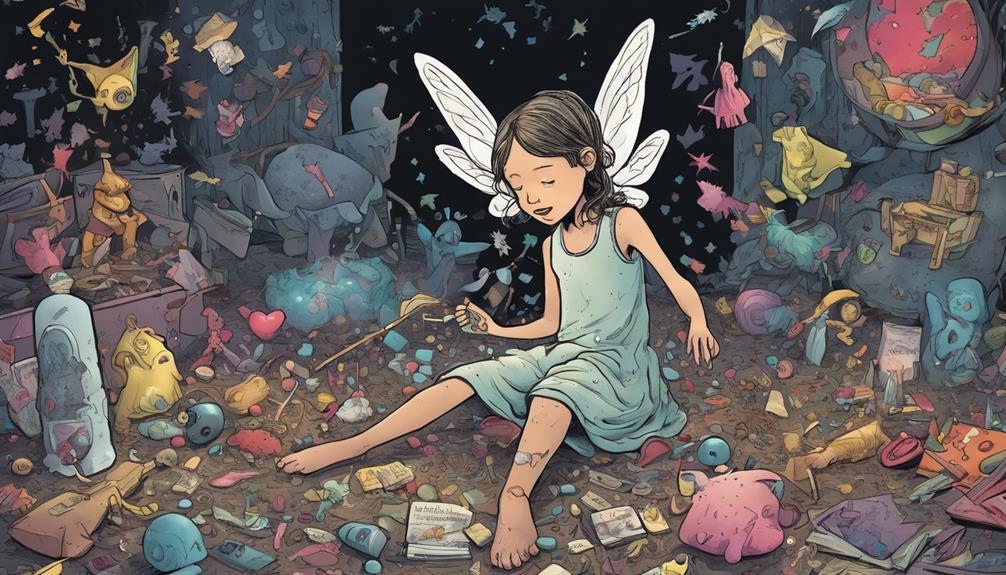
As you navigate the bittersweet journey of growing up, your beliefs about magic naturally evolve, reflecting your cognitive development and changing understanding of the world. The enchanting idea of Tooth Fairies collecting Baby Teeth may seem real at first, but around ages 7-8, you might start questioning these fantasies. This shift marks a significant moment in your evolving beliefs about magic.
Consider these aspects of your magical journey:
- Cultural Variations: Different societies have unique tooth-related myths, like Ratoncito Pérez in Spanish-speaking countries.
- Parental Influence: Your parents play a vital role, balancing the magic of belief and the importance of critical thinking.
Believing in fantasy can spark joy, but as you grow, understanding the deeper meanings behind these traditions enriches your experience.
Embracing this evolution, you can treasure the magic of your childhood while stepping confidently into a more nuanced view of the world around you.
The Fear of Being Forgotten

The Tooth Fairy experiences a deep-seated fear of being forgotten as children move into adulthood and begin to question the magic of their childhood. When kids stop believing, her significance in their lives diminishes, making her role feel less important. This fear is intensified as children reach ages 7-8, a time when they often start doubting mythical figures.
| Factors Impacting the Tooth Fairy's Role | Implications for Children |
|---|---|
| Age of questioning | Diminished belief |
| Cultural competition | Alternatives emerge |
| Economic shifts | Financial exchanges weaken |
| Pragmatic understanding of value | Real-life concerns prevail |
| Shift in traditions | Loss of unique identity |
As you grow older, you might find that the Tooth Fairy competes with other narratives and customs, like Ratoncito Pérez. This competition heightens her fear of being forgotten. The Tooth Fairy hopes to remain a cherished figure in children's imaginations, but if belief fades, so does her magic. Remember, every lost tooth is a chance for her to stay alive in your heart!
Impact of Parental Influence

Parental involvement shapes children's beliefs about the Tooth Fairy, ensuring that the magic of the tradition remains alive and vibrant. When you engage in rituals like hiding teeth and leaving money, you're not just participating in a fun activity; you're reinforcing the Tooth Fairy myth in your child's mind. Your attitudes toward fantasy figures greatly influence how robustly your child believes in this magical being.
Consider these elements of parental influence:
- Ritual Participation: Your active role in the Tooth Fairy tradition fosters excitement and belief.
- Societal Expectations: You may feel pressure to maintain the myth, driven by the desire to uphold childhood innocence.
Research shows that while children can differentiate between fantasy and reality, your reinforcement plays an important role in shaping their understanding.
With your support, the Tooth Fairy remains a cherished part of childhood, helping to create lasting memories and a sense of wonder.
Cultural Shifts in Mythology

Cultural shifts have transformed the Tooth Fairy mythology, adapting it to reflect contemporary values and beliefs while maintaining its enchanting essence. As children believe in this whimsical figure, the story has evolved through cultural changes that mirror societal shifts. Originally rooted in Norse customs, the Tooth Fairy gained popularity in the U.S. in the early 20th century, influenced by a blend of immigrant rituals and maternal figures.
Different cultures, like Ratoncito Pérez in Spanish-speaking countries and Toppolino in Italy, showcase how the Tooth Fairy tradition adapts to local customs while retaining the core idea of exchanging teeth for rewards.
Additionally, the rise of digital media has shaped how children perceive the Tooth Fairy, with films and books emphasizing her positive traits and role in childhood mythology.
Economic factors also play a significant role in this evolution. The monetary compensation for lost teeth has fluctuated, reflecting broader societal shifts in economic conditions and parental expectations.
As you navigate these changes, it's clear the Tooth Fairy must adapt to remain relevant in the hearts and minds of children around the world.
Frequently Asked Questions
What Are the Tooth Fairy's Superpowers?
The Tooth Fairy's superpowers include invisibility, allowing her to visit unnoticed, and flight, enabling swift travel. She transforms teeth into gifts, empathizes with children's feelings, and fosters excitement around dental health, promoting good hygiene habits.
What Is the Tooth Fairy's Favorite Animal?
Imagine the Tooth Fairy as a gentle breeze through a twilight garden; she adores small, magical creatures. Her favorite animals often include rabbits and owls, symbolizing innocence and the enchanting wonders of the night.
Conclusion
In the end, the tooth fairy's fears mirror our own as childhood innocence fades like a sunset slipping below the horizon.
As beliefs shift and parental influences shape our perceptions, she worries about becoming a mere whisper in the wind of forgotten traditions.
But as long as children hold onto their dreams, the magic can live on, reminding us all of the wonder that exists in believing—even when the world around us changes.

